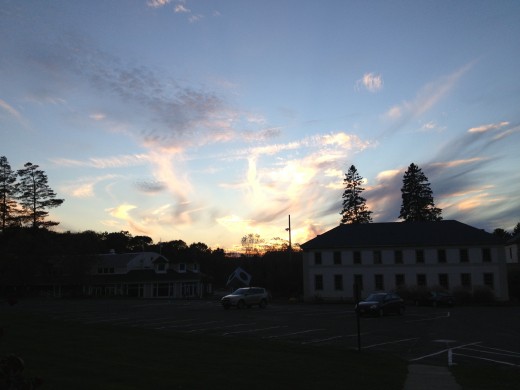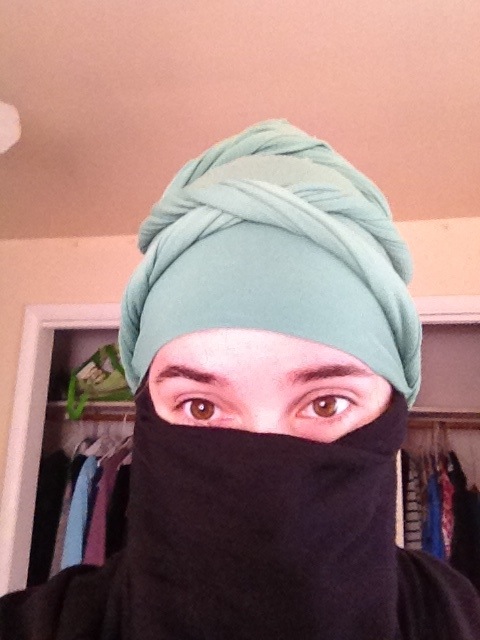Goodbye Sonnets!
We did our final performance of our chosen sonnets on Monday night, in what was something of an anticlimactic evening. I think I only feel that way because the final performance of sonnets at the Month-Long is so spectacular and special, a culmination of Elizabethan World Picture Day, lit with candles and surrounded by art and reverence. This was a much simpler close to our sonnet work, and I was sad to see them go. The sonnets are so very rich, I’m thinking of devising some way to keep working on them on a regular basis. I must get my machinations in order.
And Hello Clown!
That’s right, I said clown. And now many people I know are having an overwhelming impulse to run and hide.
It’s fascinating to me how divisive clown class is. It’s hard, that’s no joke, but I also find it super fun and incredibly challenging (which is one of the things I found fun about it). But I kind of understand those who hate it – first, it’s exhausting. Pure clown is done at a super high energy level, something our instructor Toomey called the “red zone.” It’s a place of such high energy that complex thought simply isn’t possible (which is good, because clowns only have three brain cells and no memory). It’s a challenge to reach the red zone, and it’s harder still to maintain it.
Also, pure clown is exceedingly vulnerable. Whereas much of our training has been about identifying our habits and “off-balances” and letting go of them to find a more centered and neutral place from which to start working (ensuring that any use of habitual movements or tensions is a choice, rather than an unconscious happening), clown is about finding those off-balances and magnifying them, or “pushing them into the space.” In order to do this, clown students have to be willing to not only face those off-balances head on, but embrace them and love them and be willing to take them to a grotesque level.
Yeeeaah. Imagine staring at the habits or characteristics that many would consider faults, and agreeing to make them large enough so that others can laugh at them. It can be rough. But it’s also an amazing fast track to self-awareness.
And we’re not just putting this all on display and then leaving them like an art installation, for people to react how they will. In pure clown, the connection with the audience is key. Side coaching will almost always include a request to “see us,” and then “have a thought and share it.” Nothing is private, nothing is hidden, and as the clown I will watch and take note of every bit of audience reaction to my thoughts, feelings, and imbalances.
It’s hilarious.
And THEN, in comes the Authority, signified by a specific hat Toomey would wear. The Authority (who must always be pleased), may appear in order to chastise or encourage a clown. Often to cause some kind of change, or present an obstacle the clown must then deal with. While everyone watches (“see us”).
As in the Month-Long, we started clown with playing games – red light/green light, the hand slapping game etc. We were asked to take note of how we play, as often how we play is indicative of elements of our personalities. While we may have worked to smooth out our competitiveness or our belief in fairness in our adult lives, playing schoolyard games will often bring those qualities to the forefront once again.
But it wasn’t all fun and games for long. On the evening of our first day (did I mention that our other classes were put on hold in order to dive completely into clown for a couple of days?), we participated in the Ring of Fire. Our chairs were set in a circle, with a slight opening at one point. We were asked to, one at a time, get our energy up (usually accomplished by running around and yelling or singing), and when it was close to the red zone, we were to enter the ring, while everyone else sat in their chairs. Each person had a ten minute time limit, during which our goal was to get everyone in the circle to laugh. A real laugh, a guffaw, none of that chuckle nonsense. And it had to be at the same time. Everyone, laughing, at the same time.
Has anyone ever asked you to be funny? If you’re like 90% of the world, such a request conjures up a fight or flight response. We were no different. We were allowed to do whatever we wanted inside that ring, full permission. The only exception was we couldn’t harass the audience in any way. “Harass” had a loose interpretation, and often was interpreted as directing attention at any one person for too long.
Now, you should know that usually when the Ring of Fire is performed, there isn’t any time limit. In fact, the person in the ring isn’t allowed to leave the ring for any reason until they have accomplished the goal. It can last for days. So we got off easy. Or something.
I was the penultimate person to go, and I decided to eschew words or stories, as I had seen that didn’t really work for the people going before me (with one exception). Instead I did what I do best: made up songs while doing the running man. And I got close. Really close. Several times. I tried to channel my discomfort into wordless songs and ridiculous movements. For ten solid minutes. But each time I got a big laugh there was at least one hold out. Jerks.
Only two people got out before the 10 minute time limit. I wish I could tell you how they accomplished it. But even if I recounted in detail Becca’s impeccable timing and use of Winnie the Pooh quotes, or the way Cate took advantage of her disgust with feet, I don’t think it would translate. So you should just set up your own Ring of Fire and give it a try. Try it, you’ll like it. Maybe.
On day 2 we were asked to come in disguise. Here’s mine:
Paul asked if I were a mummy ninja. I was thinking more about Dune and stillsuits.
We worked the entire day in those disguises, with additional motley thrown on. It was a hot, sweaty and long day.
In the afternoon we started to do a little work clarifying our clowns. Each person would get up and enter the space from behind the gym mats, which had been set on end like walls to create wings or offstage space, and see the audience. Then see the space, realize we were in the wrong space, and then exit the space. Only it’s clown, so it’s never really that simple. The Authority might appear at any moment to ask certain things of the clown, and there would inevitably be side coaching to help keep us on track (“see us,” “have a thought and share it,” “now exit the space. Exit the space. Exit The Space”). And then Toomey would start to talk about what he would see in our clowns – physical tics and gestures to magnify and explore.
Here’s what I learned about my clown: she’s old. Like, REALLY old. And maybe a witch? There’s something very straight up and down about her, and she has this slight head dip. Also, she swears under her breath. A lot.
Toomey also asked me if people often tell me I’m intense. And my answer was a surprised “no.” Now that I’m writing this many weeks later, I can speak with a bit more experience and say that my intensity is something I try to alleviate with humor, but it’s there. Oh, it’s there.
On the evening of the second day we did an exercise around a water glass. And I know this post is super long and maybe this isn’t super interesting to you, but this is also my record for personal use and I want to remember this, so suck it.
He set up the stage once again, this time with a table and chair downstage left. On top of the table was a pitcher very full of water, and a plastic cup. We were asked to enter stage right, move to the table, pour a glass of water, drink it and exit the space. The set-up was that we had been without water for weeks, so this water was exceedingly important. Easy enough, right? WRONG. First rule: if the clown was going to change direction, she had to first look in that direction. This includes up and down (i.e. sitting down, standing up, reaching for a pitcher, etc). Second rule: if the clown was moving, she had to be in eye contact with the audience. Why yes, that does mean that eye contact with the audience had to be maintained while walking to the chair, sitting in the chair, reaching for the pitcher, pouring the glass, and drinking the water. All of this punctuated with stopping in order to look in the direction of the next movement.
If the clown broke any of the rules, she had to sit down.
Who ruled at this exercise? Oh, that would be me. I drank an entire glass of water, was on my way out, and was directed by the Authority to have another glass. Oh yes, the Authority made many appearances, to chide me for the way I was holding the pitcher, or drinking the water, or sitting in the chair. And my clown’s tendency to swear was ever present.
As well as my affinity for “getting busted.” Getting busted is what happens when the actor laughs at what is happening. This is markedly different from when the clown laughs, and it’s caused by the actor’s energy skyrockets unexpectedly. And I do it. A lot.
After judging myself to be successful in Ring of Fire (so close!) and the water glass exercise, day three was a bit of a struggle. I continued to get busted. All over the place. And I was asked to move more fully into anger throughout several subsequent exercises. We’ve talked about anger here, so you already know how hard that is for me. Also, I forgot to take notes on what we did on day three.
But that’s okay, because there’s more clown in week seven!
Other Stuff
It would be nice to say that the week ended there. Three 13 hour days of clown was certainly exhausting enough to have warranted it. But no. It was time to move into King John.
I’ve told you a bit about dropping in – feeding in a separate activity, and it’s a bit more straightforward. Basically we set up a stage, in this case actors in the middle of a large circular playing space, observers creating that circle with their chairs. Each actor had someone to feed her in, and that person would stand behind her so the actor could fully commit to interacting with other actors. The person feeding in the actor would read them a line of text, and the actor would repeat it, free from paper and from words on a page, and with full license to move.
We did this for the entire show.
It was hard at times to follow what was going on, getting only one line at a time, but feeding in is really a remarkable process. It allows the actors to take the words, and have a physical experience with them. Instead of getting trapped in the intellectual and “doing it right,” license is given and the physical experience becomes the thing. As you can imagine, it takes a while.
The last piece of this epic week was our audition class, and we focused on Modern pieces once again. I worked up a piece of George Bernard Shaw’s Androcles and the Lion, and it’s a keeper. Once again, this class proves amazingly useful and I really knocked it out of the park with my audition outfit, if I do say so myself. Truly, it was recommended that Becca and I start a business helping actresses for auditions and I kind of want to make it happen.
Pictures!!
Also, October was gorgeous. Here’s a few treats for your eyeballs.


